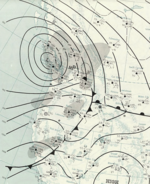The Columbus Day Storm of 1962 was an extratropical wave cyclone that ranked among the most intense to strike the United States Pacific Northwest since the January 9, 1880, "Great Gale" and snowstorm. On a larger scale, the Columbus Day Storm of 1962 is a contender for the title of most powerful extratropical cyclone recorded in the U.S. in the 20th century. Only hurricanes of Category 3 or higher have brought winds of the magnitude witnessed in Oregon and Washington on Columbus Day, October 12, 1962. A tropical storm named Freda formed about 500 miles/800 km from Wake Island in the central Pacific Ocean. The system became an extratropical cyclone as it moved into colder waters and interacted with the jet stream. This storm moved northeastward, and then hooked straight north as it neared southwest Oregon before moving northward at an average speed of 40 mph (64 km/h) or greater, with the center just off of the Pacific Coast. It made landfall on Vancouver Island, British Columbia, where it weakened rapidly. At the Mt. Hebo Air Force Station in the Oregon Coast Range, the anemometer pegged at its maximum 130 mph (209 km/h) for long periods—likely at the level of a Category 4 hurricane; damage to the radar domes suggested wind gusts to at least 170 mph (270 km/h). At least 46 fatalities were attributed to this storm, more than for any other Pacific Northwest wind event. The dollar damage adjusted to 2002 for inflation and population/property increase suggest a $3 to $5 billion storm.
